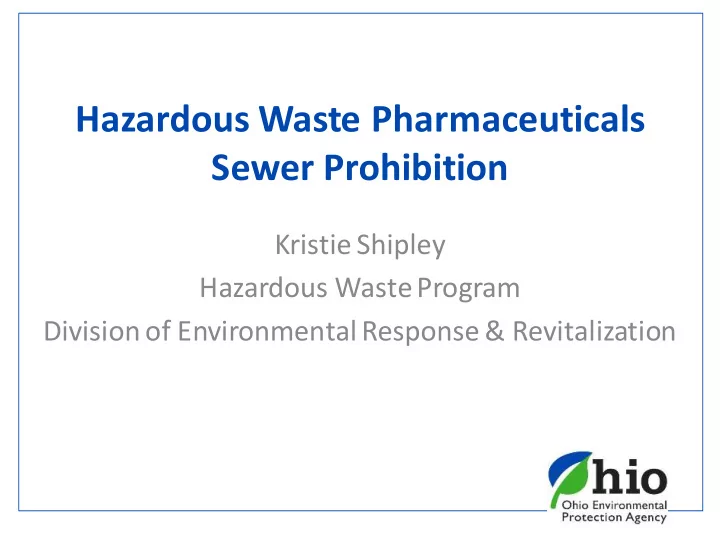

Hazardous Waste Pharmaceuticals Sewer Prohibition Kristie Shipley Hazardous Waste Program Division of Environmental Response & Revitalization
Agenda ▪ Introduction ▪ Background ▪ Applicability/Definitions ▪ Management ▪ Questions
US EPA Final Rule Final Rule: Management Standards for Hazardous Waste Pharmaceuticals ▪ § 266.505 Sewer Prohibition - August 21, 2019
Background RCRA domestic sewage exclusion in § 261.4(a)(1)(ii) ▪ Any mixture of domestic sewage and other wastes that passes through a sewer system to a publicly- owned treatment works for treatment. ▪ Not considered solid wastes up to this point
Clean Water Act Ignitable and some reactive and corrosive wastes are already prohibited from being discharged to the sewer system under the Clean Water Act § 403.5(b)
Authority Hazardous and Solid Waste Amendments (HSWA) 1984 ▪ Allows for revision of regulations to ensure substances which pass through a sewer system to POTW are adequately controlled
Background ▪ No pollutant discharge limits that apply to healthcare facilities discharging pharmaceuticals to POTWs ▪ Wastewater treatment is not designed to remove pharmaceuticals
Background Projected to prevent the flushing of 1,644 to 2,300 tons of hazardous waste pharmaceuticals annually
Applicability ▪ All healthcare facilities that generate, accumulate, or otherwise handle hazardous waste pharmaceuticals ▪ Including CESQGs ▪ Reverse distributors engaged in the management of prescription hazardous waste pharmaceuticals
Definition Healthcare facility: (1) provide preventative, diagnostic, therapeutic, rehabilitative, maintenance or palliative care, and counseling, service, assessment or procedure with respect to the physical or mental condition, or functional status, of a human or animal or that affects the structure or function of the human or animal body • any drug or dietary supplement for use by humans or other animals; any electronic nicotine delivery system, or any liquid nicotine packaged for retail for use in electronic nicotine delivery systems (e.g., pre-filled cartridges or vials).
Definition Healthcare facility: (2) distribute, sell, or dispense pharmaceuticals, including OTC pharmaceuticals, dietary supplements, homeopathic drugs, or prescription pharmaceuticals • any drug or dietary supplement for use by humans or other animals; any electronic nicotine delivery system, or any liquid nicotine packaged for retail for use in electronic nicotine delivery systems (e.g., pre-filled cartridges or vials).
Healthcare Facilities Psychiatric Ambulatory Hospitals Health clinics hospitals surgical centers Optical & Physicians’ Long term care dental Chiropractors offices facilities providers Ambulance Retailers of OTC Veterinary Pharmacies services medications clinics/hospitals
Definition Reverse distributor: Any person that receives and accumulates prescription pharmaceuticals that are potentially creditable hazardous waste pharmaceuticals for the purpose of facilitating or verifying manufacturer credit • any drug or dietary supplement for use by humans or other animals; any electronic nicotine delivery system, or any liquid nicotine packaged for retail for use in electronic nicotine delivery systems (e.g., pre-filled cartridges or vials).
Definition Pharmaceutical: Any drug or dietary supplement for use by humans or other animals, any electronic nicotine delivery system, or any liquid nicotine packaged for retail for use in electronic nicotine delivery systems (e.g., pre-filled cartridges or vials). • any drug or dietary supplement for use by humans or other animals; any electronic nicotine delivery system, or any liquid nicotine packaged for retail for use in electronic nicotine delivery systems (e.g., pre-filled cartridges or vials).
Pharmaceuticals Dietary Prescription drugs OTC drugs supplements Homeopathic Compounded Investigational drugs drugs drugs Pharmaceuticals Personal protective Clean-up material remaining in equipment (pharmaceutical containers (contaminated) spills)
Hazardous Waste Pharmaceutical ▪ Listed hazardous waste – Approximately 30 products listed on the P and U lists with pharmaceutical uses ▪ Characteristic hazardous waste – Ignitable, corrosive, reactive or toxic
DEA Controlled Substances Name of Drug Other Name(s) Medical Uses RCRA DEA CS HW Code Schedule Chloral/ Chloral Acetaldehyde, Sedative U034 IV trichloro; Aquachloral hydrate T oxic Noctec, Somnote, Supprettes Fentanyl sublingual Subsys Analgesic D001 II spray ignitable Bellergal-S Phenobarbital Anticonvulsant D001 IV Donnatal ignitable Luminal T estosterone Androgel Axiron Hormone D001 III gels/solutions Fortesta,T estim ignitable Valium Diazepam Anti-anxiety D001 IV injectable/gel Diastat ignitable
Applicability Summary Are you a healthcare facility of reverse distributor? Do you generate pharmaceutical waste? Is it a hazardous waste?
Management Need to manage as hazardous waste ▪ Chapter 3745-52 Generator Standards Generator categories: ▪ CESQG: ≤ 1 kg acute, ≤ 100 kg hazardous ▪ SQG: > 100 kg and < 1,000 kg hazardous ▪ LQG: > 1 kg acute, ≥ 1,000 kg hazardous
Management Satellite accumulation (SQG/LQG) ▪ 55 gallons of non-acute ▪ 1 quart of acute ▪ At or near the point of generation
Management Container management (SQG/LQG) ▪ Good condition ▪ Compatible with waste ▪ Labeled as hazardous waste ▪ Maintain aisle space and lids ▪ Conduct weekly inspections ▪ Label accumulation start date (unless a satellite accumulation area)
Management Training (SQG/LQG) ▪ All employees must be thoroughly familiar with proper waste handling and emergency procedures, relevant to their responsibilities Emergency equipment (SQG/LQG) ▪ Internal communication or alarm system ▪ Telephone or two-way radio ▪ Fire, spill control and decontamination equipment
Management ▪ 180-day storage limit SQG ▪ 90-day storage limit LQG
Management Emergency procedures: ▪ (SQG) Emergency Coordinator’s response required ▪ (LQG) Written contingency plan and emergency procedures required
Management Land Disposal Restriction (SQG/LQG) ▪ Determine if waste must be treated before it can be land disposed (or write on manifest that a determination has not been made) ▪ One-time written notice to each treatment storage disposal facility receiving your hazardous waste
Management Reporting ▪ (LQG) Biennial report due March 1 st in even numbered years for previous year
Management Recordkeeping (SQG/LQG) ▪ Manifests ▪ LDR notification ▪ Exception reports ▪ Waste evaluation ▪ Training ▪ Biennial Report ▪ (kept on-site for at least 3 years)
Management Hazardous waste pharmaceuticals should NOT be placed in red sharps containers ▪ Biohazardous waste/infectious waste
Summary August 21 st -Hazardous waste pharmaceuticals may not be sewered (drain / flushing) Sewering of any pharmaceuticals is highly discouraged
Questions? Kristie Shipley 614-728-5363 Kristie.Shipley@epa.ohio.gov Compliance Assistance Hotline: (800) 329-7518 (anonymous)
Recommend
More recommend